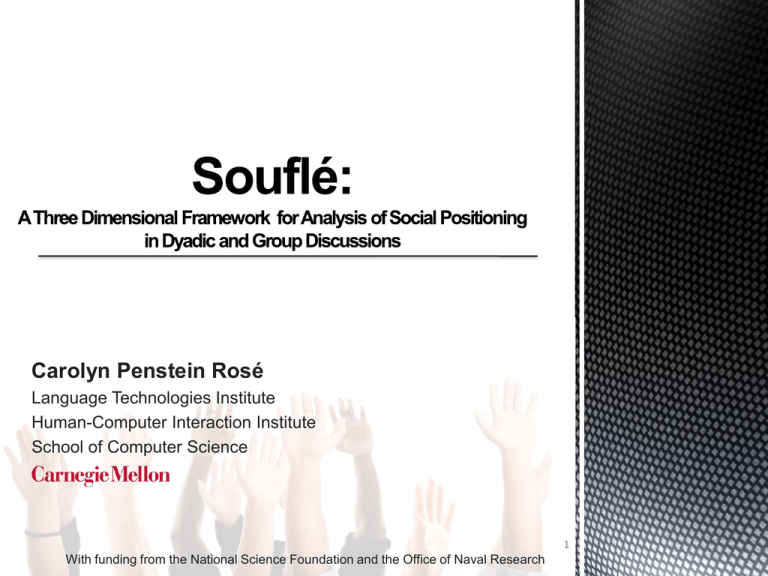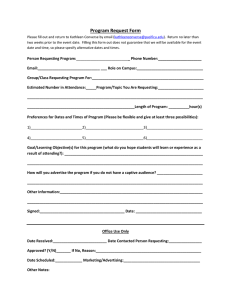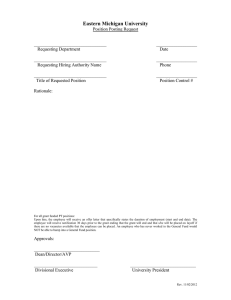Carolyn Penstein Rosé Language Technologies Institute Human-Computer Interaction Institute School of Computer Science
advertisement

Carolyn Penstein Rosé Language Technologies Institute Human-Computer Interaction Institute School of Computer Science 1 With funding from the National Science Foundation and the Office of Naval Research Outline • Introducing the Problem of Supporting Productive Discussion for Learning • Discussion of Souflé • Transactivity • Engagement • Authoritativeness • 2 End of Fall Semester: Students learn about Rankine Cycles 1 Week of lectures Homework assignment on analysis of Rankine Cycles Tutorial on using CyclePad software package (Developed at Northwestern University (Forbes et. al. 1999) Allows students to construct and analyze a variety of Thermodynamic Cycles) Instructed on Effects of Changing System Variables (Temperature, Pressure) on System Output (Power, Waste Heat) Learning Goal: Encourage students to reflect on interactions between cycle parameters Increasing heat increases power but also waste heat Increasing pressure increases efficiency Reduction in Steam Quality Waste Heat Design Goal: Design a power plant based on the Rankine Cycle paradigm Competing Student Goals: Power Power: Design a power plant that achieves maximum power output Motivated by economic concerns Green: Design a power plant that has the minimum impact on the environment Motivated by environmental concerns Each pair turns in exactly one design 5 S fl Person Person 3 Dimensions: Transactivity Engagement Authoritativeness 6 Transactive Knowledge Integration Person Person 7 • Definition of Transactivity • building on an idea expressed earlier in a conversation • using a reasoning statement We don't want tmax to be at 570 both for the material and [the Environment] well, for power and efficiency, we want a high tmax, but environmentally, we want a lower one. 8 9 10 11 Transactivity (Berkowitz & Gibbs, 1983) Findings Moderating effect on learning (Joshi & Rosé, 2007; Russell, 2005; Kruger & Tomasello, 1986; Teasley, 1995) Moderating effect on knowledge sharing in working groups (Gweon et al., 2011) Computational Work Can be automatically detected in: Threaded group discussions (Kappa .69) (Rosé et al., 2008) Transcribed classroom discussions (Kappa .69) (Ai et al., 2010) Speech from dyadic discussions (R = .37) (Gweon et al., 2012) Predictable from a measure of speech style accommodation computed by an unsupervised Dynamic Bayesian Network (Jain et al., 2012) Transactive Knowledge Integration Engagement Person Person Engagement 13 System of Engagement Showing openness to the existence of other perspectives Less final / Invites more discussion Example: [M] Nuclear is a good choice [HE] I consider nuclear to be a good choice [HC] There’s no denying that nuclear is a superior choice [NA] Is nuclear a good choice? 14 15 Engagement (Martin & White, 2005) Findings Correlational analysis: Strong correlation between displayed openness of group members and articulation of reasoning (R = .72) (Dyke et al., in press) Intervention study: Causal effect on propensity to articulate ideas in group chats (effect size .6 standard deviations) (Kumar et al., 2011) Mediating effect of idea contribution on learning in scientific inquiry (Wang et al., 2011) Authority Transactive Knowledge Integration Engagement Person Person Engagement Authority 17 Analysis of Authoritativess Water pipe analogy: Water = Knowledge or Action Source = Authoritative speaker Sink = Non-authoritative Speaker Authoritativeness Ratio = Source Actions Actions 18 K2 requesting knowledge, information, opinions, or facts K1 A2 giving knowledge, information, opinions, or facts Instructing, suggesting, or requesting non-verbal action A1 Narrating or performing your own non-verbal action Additionally… ch (direct challenge to previous utterance) o (all other moves, backchannels, etc.) 19 K2 requesting knowledge, information, opinions, or facts K1 A2 giving knowledge, information, opinions, or facts Instructing, suggesting, or requesting non-verbal action A1 Narrating or performing your own non-verbal action 20 K2 requesting knowledge, information, opinions, or facts K1 A2 giving knowledge, information, opinions, or facts Instructing, suggesting, or requesting non-verbal action A1 Narrating or performing your own non-verbal action 21 K2 requesting knowledge, information, opinions, or facts K1 A2 giving knowledge, information, opinions, or facts Instructing, suggesting, or requesting non-verbal action A1 Narrating or performing your own non-verbal action K2 requesting knowledge, information, opinions, or facts K1 A2 giving knowledge, information, opinions, or facts Instructing, suggesting, or requesting non-verbal action A1 Narrating or performing your own non-verbal action Additionally… ch (direct challenge to previous utterance) o (all other moves, backchannels, etc.) 23 K2 requesting knowledge, information, opinions, or facts K1 A2 giving knowledge, information, opinions, or facts Instructing, suggesting, or requesting non-verbal action A1 Narrating or performing your own non-verbal action Additionally… ch (direct challenge to previous utterance) o (all other moves, backchannels, etc.) Authoritativeness: K1 + A2 K1 + K2 + A1 + A2 24 K2? 25 Set up! K2 K1 26 27 Authoritativeness (Martin & Rose, 2003) Findings Authoritativeness measures display how students respond to aggressive behavior in groups (Howley et al., in press) Authoritativeness predicts learning (R = .64) and self-efficacy (R = .35) (Howley et al., 2011) Authoritativeness predicts trust in doctor-patient interactions (R values between .25 and .35) (Mayfield et al., under review) Computational Work Detectable in collaborative learning chat logs (R = .86) Detectable in transcribed dyadic discussions in a knowledge sharing task (R = .95) (Mayfield & Rosé, 2011) Detectable in transcribed doctor-patient interactions (R = .96) (Mayfield et al., under review) 29


